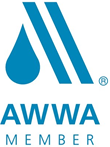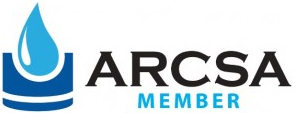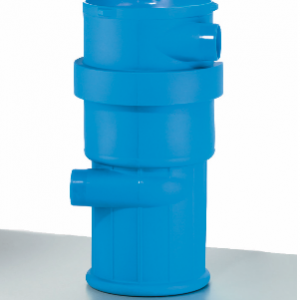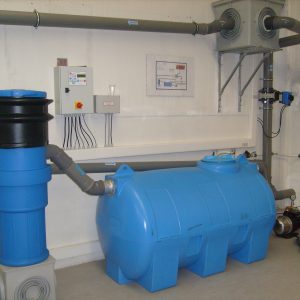Description
Specialist rainwater filter for installation directly in the ground, for heavily contaminated traffic areas up to 100m². The filter function is an up-flow process and this allows for a design with little height difference between inlet and outlet. The cleaned water has an excellent water quality. The rainwater is cleaned by basic operation of the following processes: Sedimentation, Adsorption, Filtration, and Chemical Precipitation. Incoming rainwater is led down to the basal section of the filter shaft. A hydrodynamic separator built in the base section promotes particulate sedimentation.
The water is led into this separator tangentially and generates a radial flow pattern. Particles settle into the silt trap located below the separation chamber. As there is no current there is little remobilisation (washout) of the retained sediment. Above the separation chamber is the filter element, occupying the full shaft width and so all water must flow up through it. The Siltation of this filter is slowed due to the upwards flow, and the fact that the filter is below the water level. The filter is easily exchanged. The complete single filter element is removed using the handle inside the overflow pipe. Under normal conditions the filter will last for 2 years, maintenance free.
How it works:
- The rainwater from the connected area is fed into the basal section of the filter housing. The angled inlet generates a radial flow pattern.
- The hydrodynamic separator converts turbulent waters into a radial laminar flow pattern, generating particle sedimentation, particularly of the sand fraction.
- This takes place over an inlet to the lower section of the filter shaft. The sediment is retained in a silt trap chamber below the separator. The silt trap can be withdrawn for cleaning, and has an integral cleaning port to the side to ease dirt removal, (see 6).
- In the central section of the filter housing is the actual filter, Filter Roof. The filter element filters out the fine materials in an up-flow process and dissolved materials are precipitated and adsorbed. The filter is backwashed from above. When exhausted the filter is easily exchanged.
- The filter element is easily pulled up and removed from the shaft housing.
Product Components
- Rainwater inlet
- Separator
- Sediment basket
- Maintenance opening for cleaning
- Removal Handle, chamber removal
- Rubber seal (Ø 30 mm)
- Filter element with substrate and cover made of stainless steel
- Lifting eye for filter removal
- Latch for buoyancy protection (2 off)
- Emergency overflow
- Cleaned water outlet to tank or to infiltration system
- Telescopic extension




